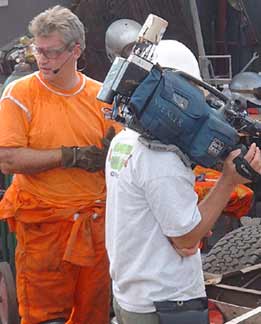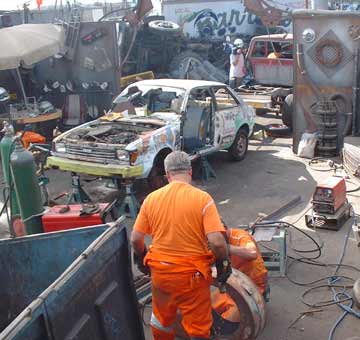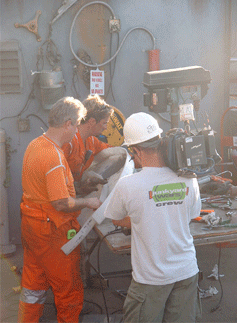

Jim Adair, vice president of Schwarze Industries, Inc., was chosen as the expert for the air sweeper build team, The Sewer Rats. Here's what took place from his perspective:
 I first learned about Junkyard Wars only a little over two weeks prior to when the show was slated to be taped. A member of the production company, RDF Media, called up and told me about the project. Personally, it was quite a process to go through, since I had such a short amount of preparation time before the event. Prior to the day we actually built the sweepers I had to come up with some plans, a compilation of building materials we'd have to have as well as a list of the types of items we could use as scavenged parts. I had to come up with different scenarios that might work, in other words, several ways showing how we could build an air sweeper. In a sense, they wanted me to provide them with an explanation of how air sweepers work.
I first learned about Junkyard Wars only a little over two weeks prior to when the show was slated to be taped. A member of the production company, RDF Media, called up and told me about the project. Personally, it was quite a process to go through, since I had such a short amount of preparation time before the event. Prior to the day we actually built the sweepers I had to come up with some plans, a compilation of building materials we'd have to have as well as a list of the types of items we could use as scavenged parts. I had to come up with different scenarios that might work, in other words, several ways showing how we could build an air sweeper. In a sense, they wanted me to provide them with an explanation of how air sweepers work.
Brian Giles, Elgin's team expert for the opposing team, Trash Can Heroes, and I first met with our prospective teams for dinner the night before the show was taped. We were strictly forbidden to give any clues about what either of us did as occupations or what we were all going to be building the next day.
We all got together again on the show's junkyard-styled set at 7am the next morning. First a round of pictures were taken and we went over some safety issues and had breakfast together. It wasn't until just before the 10am start time for taping that we broke the news to the teams about what they'd be building.
One of the toughest things for me, personally, once we got started, was that I couldn't go out into the junkyard to get materials. That's because, as part of the rules, both the team captain and team expert had to stay inside the build area. So, instead, I had to be as descriptive as possible about items to look for and hope for the best as our two team members went out to do the scavenging for us. The only remote advantage I had was that I'd done about a 10 minute walk-through of the junkyard on the previous day. It didn't provide much help in telling the guys where to look in the multi-acre junkyard set.
Our first hurdle was to find a usable truck that would start up and run. That took awhile. It was only later that we found out the truck we chose was one the junkyard folks didn't even think would run and so didn't expect us to use. One of our guys got it running, but in the process managed to catch his arm on fire! Fortunately, we were all wearing Nomex fire-retardent coveralls so he didn't get hurt seriously. The cameraman was actually the one put into danger, but he ran fast enough to keep from catching fire.
Then, once we got our truck moving, it was soon discovered that it had no brakes. So, to stop it we had to run into things. For example, to get it stopped in our building area we threw tires down at the spot we needed it to end up.
 Because we couldn't find a stationary engine of some type for a propulsion engine to turn our sweeper fan, we turned to a front wheel drive car, figuring we could attach the fan to the axle somehow. By the time we got both vehicles into where we could start work on the project, though, literally hours had gone by. It was about time for the mandatory hour-long break for lunch and we hadn't done anything at all to speak of on the fabrication end of things.
Because we couldn't find a stationary engine of some type for a propulsion engine to turn our sweeper fan, we turned to a front wheel drive car, figuring we could attach the fan to the axle somehow. By the time we got both vehicles into where we could start work on the project, though, literally hours had gone by. It was about time for the mandatory hour-long break for lunch and we hadn't done anything at all to speak of on the fabrication end of things.
With the day so far gone, we knew there was no time to take the engine out of the car, remove the wiring harness, etc., that we'd have to do in order to then mount it onto the back of the truck. So, with a stroke of genius that sometimes comes to those in desperate need, we hit upon cutting the car in half and mounting the front half onto the truck. We decided we could then mount our fan directly onto the hub of the axle and fabricate a fan housing around it.
Initially, we'd found a fan housing from a big industrial blower used to collect dust. At the time, our plan was to fabricate a fan to fit that housing. Then, one of the team members found a decent heavy-duty squirrel cage fan, so that changed our plans again, something that happened frequently throughout the day. We decided it would be easier to cut down the fan housing than to build a fan from scratch.
Unfortunately, the fan was a little smaller than we'd anticipated. This problem was compounded further once I did the math on how fast we'd have to turn the hub relative to the fan speed we'd get out of it as a direct drive. By then, though, there was no turning back. We also had some concerns about what would happen if the fan was way out of balance, since we had no way to balance it. Ultimately, we figured it might last the short amount of time needed. Besides, by this time we were out of options and very low on time remaining.
For a debris intake hose we found some clear air conditioning hoses and duct-taped them on the ends to reinforce them. We left a section clear where we could see the debris coming through. There was a potential problem with the hose, too, because it was much thinner than we'd have liked. Still, we thought it would last for the amount of time we'd be running during the tests.
 To make the sweeping head we used the bottom end of a big plastic tank. We cut sort of a half-moon shape out of it and put a rubber piece around it to form the flap area where it contacts the ground. The rubber flap material was conveyor belting, taken from a conveyor belt that was around 4 feet long. We marked it out and cut about an 8-inch strip off the whole length.
To make the sweeping head we used the bottom end of a big plastic tank. We cut sort of a half-moon shape out of it and put a rubber piece around it to form the flap area where it contacts the ground. The rubber flap material was conveyor belting, taken from a conveyor belt that was around 4 feet long. We marked it out and cut about an 8-inch strip off the whole length.
For the transition from the fan to the dumpster-turned-hopper, we scavenged a piece of pvc sewer pipe. As a team we hoisted the dumpster up onto the frame of the truck and then welded it in place. Then, we cut out a section in the side that could be opened up like a door. This would allow us to rake out the collected material the sweeper would pick up. Over the top of the dumpster we put some wire screening we'd found, in order to keep the debris from blowing out the top too badly.
To operate the contraption we'd built, we sat 4 across on it. [Editor's note: As part of the contest, all team members had to ride on the sweeper when it competed.] We had a throttle man for the car, to run the sweeper pickup fan. We designated one person be the driver for the truck. The captain looked out for everything and I ran the sweeping head. The head was rigged so I could raise and lower it depending upon what we were trying to pick up.
Looking back, the most amazing part of the building process was that we actually came up with a working air sweeper in the allotted timeframe. Literally hours passed before we started putting anything together, and there didn't seem to be nearly enough time to get it all done. I remember it seemed like the captain and I were waiting a very long time for something to do while our two eligible team members were out scavenging parts. Then, some of the first stuff they brought in were different things that had no chance of working at all. It seemed like I was discarding items as fast as they were bringing them in, and at the same time trying to give them a better idea of what would work.
The fact we had to run the sweeper itself off the drive wheel of the car made the whole project iffy, too, because automobile drive wheels just don't spin that fast. In an air machine you need lots of fan speed, and it was questionable whether we could get enough. When I did the math on the wheel rotation, it came out that for every mph the car would run we'd only get 20.9 feet per minute. As a result, we ended up having to run the car at about 100 mph in 5th gear in order to be able to get enough speed to pick material up. Not a great thing to do to an engine in an old junked car!
Ideally, of course, our air machine would be constructed to pull a vacuum on a hopper and then the debris drops out and doesn't go back through the fan. However, we didn't have that luxury, and had to figure that for the short period of time we'd be running our sweeper the fan would hold up even though material would keep coming through. I was concerned the debris they'd choose would be so solid that it would either break the fan or stop the engine/fan system. I knew that in a previous, British version of the show they'd just covered the lot with trash: paper, bottles, rocks and more, and the two sweepers were told to sweep for 20 minutes and see who could pick up the most.
Toward the end of the actual competition phase our car started blowing radiator hoses, so we had to lower the rpms to try and keep that from happening. That had an effect, of course, on the machine's pickup ability. Unfortunately, the engines on both vehicles were real wild cards; about what one would expect in a junkyard. It was hard to have any expectations about what would happen with them, because they were old engines and we had no opportunity to check them out in terms of compression or anything else. We not only didn't have any extra time to check out the engines we were using, but also had no time to repair anything if it broke.
Plus, it was extremely hot, especially later in the day when the sun started toward the horizon and came in under the overhead shade screen they'd set up for us to work under. At that point we were trying to get everything assembled and working, yet we were all approaching exhaustion, too. That factor definitely increased the difficulty. Nonetheless, I thoroughly enjoyed myself throughout the entire process, and wouldn't have missed it for anything. Anyone who's involved in the sweeping industry will want to see the show.
Go to story #3, and read a discussion between Ranger Kidwell-Ross, editor of AmericanSweeper.com, and Mark Carter, show consultant and head of L.A.-based Bill's Sweeping. What they saw taking place during the day-long build process provides an entirely new perspective on the event.
© 2005 - 2021 World Sweeper
|
Back to Junkyard Wars HomeBack to Funny BusinessSite Map / Table of Contents |